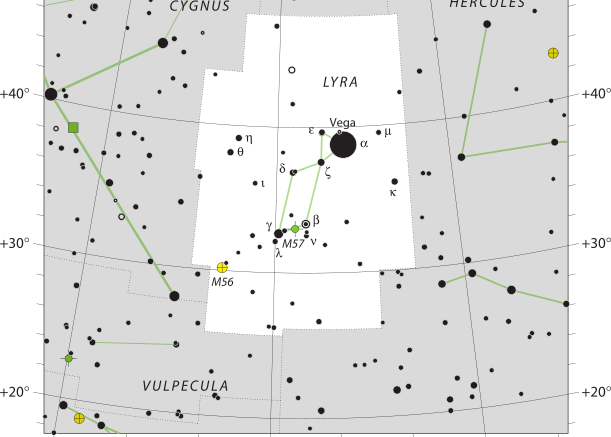The constellation Lyra is quite small only covering 286.5 square degrees, which makes it the 52nd largest in size. It appears prominently in the northern sky during the Northern Hemisphere’s summer, and the whole constellation is visible for at least part of the year to observers north of latitude 42°S. There are 73 stars in total that are brighter than magnitude 6.5.
Lyra is one of 48 constellations listed by the 2nd century astronomer Ptolemy, and was often represented on star maps as a vulture or an eagle carrying a lyre.
Lyra’s brightest star is Vega, which, is one of the brightest stars in the night sky, and is the corner of the famed Summer Triangle asterism. Beta Lyrae is the prototype of a class of binary star known as Beta Lyrae variables. Epsilon Lyrae, otherwise known as the Double Double, is a complex multiple star system. Lyra also hosts the Ring Nebula, the one of the best-known planetary nebula.
| Applicable Information | |
| Visibility In Pacific Northwest | March to November |
| Best Times To View | August |
| Right Ascension | 18h 14m to 19h 28m |
| Declination | 25.66° to 47.71° |
| Area | 286 square degrees |
| Main Stars | 5 |
| Brightest Object | Vega |
| Meteor showers | Lyrids, June Lyrids, Alpha Lyrids |
| Messier objects | 2 |
| Neighboring Constellations | Draco, Hercules, Vulpecula, Cygnus |
Myths and History
In Greek mythology, Lyra represents the lyre of Orpheus. Made by Hermes from a tortoise shell, given to Apollo as a bargain, it was said to be the first lyre ever produced. Orpheus’s music was said to be so great that even inanimate objects such as trees, streams, and rocks could be charmed. Joining Jason and the Argonauts, his music was able to quell the voices of the dangerous Sirens, who sang tempting songs to the Argonauts.
Vega and surrounding stars are also treated as a constellation in other cultures. The area corresponding to Lyra was seen by the Arabs as a vulture or an eagle carrying a lyre, either enclosed in its wings, or in its beak. In Wales, Lyra is known as King Arthur’s Harp, and King David’s harp. The Persian Hafiz called it the Lyre of Zurah.
Stars
German cartographer Johann Bayer used the Greek letters alpha to nu to label the most prominent stars in the constellation.
The brightest star is Vega, which is the 2nd-brightest star of a northern hemisphere and the fifth-brightest star in the entire sky. The only star brighter in the northern hemisphere is Arcturus and the 4 stars brighter than Vega in the entire nights sky are Arcturus, Alpha Centauri, Canopus, and Sirius. Although it was last the pole star in the year 12,000 BCE, Vega will again become the pole star around 14,000 CE.
Vega was the first star other than the Sun to be photographed, and the first to have a clear spectrum recorded, showing absorption lines for the first time.
M57, also known as the “Ring Nebula” and NGC 6720, is one of the best known planetary nebulae and the 2nd such planetary nebulae to be discovered. It was discovered in 1779 by Antoine Darquier, which is 15 years after Charles Messier discovered the Dumbbell Nebula. The outer part of the nebula appears red in photographs because of emission from ionized hydrogen. The middle region is colored green; doubly ionized oxygen emits greenish-blue light. The hottest region, closest to the central star, appears blue because of emission from helium.
Abell 46 is a planetary nebula, which is of relatively low surface brightness compared to the central star, and is undersized for the primary’s mass for reasons not yet fully understood.
NGC 6791 is a cluster of stars in Lyra and is one of the most studied stars in the sky.
NGC 6745 is an irregular spiral galaxy, which collided with a smaller galaxy that created a region filled with young, hot, blue stars.
Make sure to check out other articles on the site, including a brief introduction to constellations, other constellation articles, and more!

Be the first to comment on "Lyra"